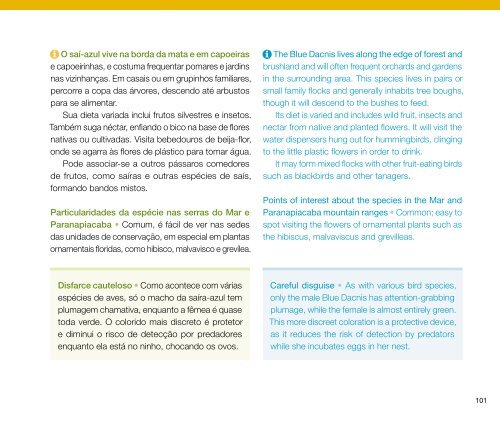Guia de aves Mata Atlântica Paulista - Secretaria do Meio Ambiente
Guia de aves Mata Atlântica Paulista - Secretaria do Meio Ambiente
Guia de aves Mata Atlântica Paulista - Secretaria do Meio Ambiente
Create successful ePaper yourself
Turn your PDF publications into a flip-book with our unique Google optimized e-Paper software.
O saí-azul vive na borda da mata e em capoeiras<br />
e capoeirinhas, e costuma frequentar pomares e jardins<br />
nas vizinhanças. Em casais ou em grupinhos familiares,<br />
percorre a copa das árvores, <strong>de</strong>scen<strong>do</strong> até arbustos<br />
para se alimentar.<br />
Sua dieta variada inclui frutos silvestres e insetos.<br />
Também suga néctar, enfian<strong>do</strong> o bico na base <strong>de</strong> flores<br />
nativas ou cultivadas. Visita bebe<strong>do</strong>uros <strong>de</strong> beija-flor,<br />
on<strong>de</strong> se agarra às flores <strong>de</strong> plástico para tomar água.<br />
Po<strong>de</strong> associar-se a outros pássaros come<strong>do</strong>res<br />
<strong>de</strong> frutos, como saíras e outras espécies <strong>de</strong> saís,<br />
forman<strong>do</strong> ban<strong>do</strong>s mistos.<br />
Particularida<strong>de</strong>s da espécie nas serras <strong>do</strong> Mar e<br />
Paranapiacaba • Comum, é fácil <strong>de</strong> ver nas se<strong>de</strong>s<br />
das unida<strong>de</strong>s <strong>de</strong> conservação, em especial em plantas<br />
ornamentais floridas, como hibisco, malvavisco e grevílea.<br />
The Blue Dacnis lives along the edge of forest and<br />
brushland and will often frequent orchards and gar<strong>de</strong>ns<br />
in the surrounding area. This species lives in pairs or<br />
small family flocks and generally inhabits tree boughs,<br />
though it will <strong>de</strong>scend to the bushes to feed.<br />
Its diet is varied and inclu<strong>de</strong>s wild fruit, insects and<br />
nectar from native and planted flowers. It will visit the<br />
water dispensers hung out for hummingbirds, clinging<br />
to the little plastic flowers in or<strong>de</strong>r to drink.<br />
It may form mixed flocks with other fruit-eating birds<br />
such as blackbirds and other tanagers.<br />
Points of interest about the species in the Mar and<br />
Paranapiacaba mountain ranges • common; easy to<br />
spot visiting the flowers of ornamental plants such as<br />
the hibiscus, malvaviscus and grevilleas.<br />
Disfarce cauteloso • Como acontece com várias<br />
espécies <strong>de</strong> <strong>aves</strong>, só o macho da saíra-azul tem<br />
plumagem chamativa, enquanto a fêmea é quase<br />
toda ver<strong>de</strong>. O colori<strong>do</strong> mais discreto é protetor<br />
e diminui o risco <strong>de</strong> <strong>de</strong>tecção por preda<strong>do</strong>res<br />
enquanto ela está no ninho, chocan<strong>do</strong> os ovos.<br />
Careful disguise • As with various bird species,<br />
only the male Blue Dacnis has attention-grabbing<br />
plumage, while the female is almost entirely green.<br />
This more discreet coloration is a protective <strong>de</strong>vice,<br />
as it reduces the risk of <strong>de</strong>tection by predators<br />
while she incubates eggs in her nest.<br />
101

















